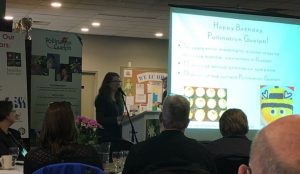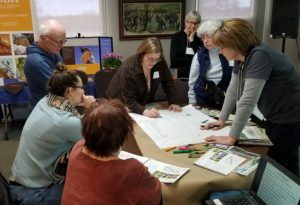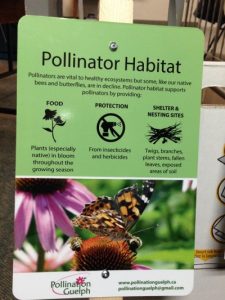by Renate Sander-Regier and Sandy Garland
This year’s Pollination Guelph symposium took place on March 10 in Guelph. It offered presentations, workshops, displays, a photo contest, and lots of helpful information and resources.
Pollination Guelph has been coordinating this popular annual event for some time, and this year it was completely sold out. Participants came from throughout southern Ontario, and as far afield as Peterborough, Ottawa, and rural west Quebec. The last two, as you may have guessed, were us. We undertook the trip to learn as much as possible from this successful regional pollinator organization.
It would take very thorough notes and more than one blog post to report on the symposium in its entirety. Instead, we just want to share the following highlights.
Pollination Guelph an inspiration

Victoria MacPhail kicked off the morning with a quick history of Pollination Guelph and its accomplishments.
Sandy: For me, the highlight of the day was the brief summary of the work that Pollination Guelph has been doing over the last 10 years. In addition to its Pollination Park, work on the Trans Canada Trail, replanting a hydro site, and developing an Ontario Pollinator Health Action Plan, the organization has provided help and advice to numerous local groups and educated many of us through social media. What a wonderful “role model” for WPP here in the Ottawa-Outaouais region.
Worth checking out: Pollination Guelph’s “our downloads” for advice on helping our local pollinators.
Bumblebee conservation breeding
Renate: It was very interesting to hear about current efforts to support the Yellow-banded Bumblebee, Bombus terricola. As we learned through a bit of research following our return from the symposium, this bumblebee’s populations have declined steeply in recent years, particularly in the southern part of its range. Bombus terricola has consequently received species at risk designations in various jurisdictions. For example:
- “Special Concern” by the Committee on the Status of Endangered Wildlife in Canada (COSEWIC)
- “Special Concern” by the province of Ontario
- “Special Concern” by the province of Quebec
- “Vulnerable” by the International Union for the Conservation of Nature
At the symposium, biologist Victoria McPhail spoke about a Wildlife Preservation Canada captive breeding program intended to reveal more about the Yellow-banded Bumblebee and to protect it in the wild. The program involves capturing queen bumblebees in the field in spring and breeding them in a controlled environment to (a) conduct laboratory experiments regarding threats to the species and (b) ultimately release the bees into the wild.
To read more about Bombus terricola and captive breeding approaches and techniques, the following sites offer excellent information:
- Xerces Society profile
- Wildlife Preservation Canada’s conservation breeding program
- Victoria McPhail’s Bombus terricola conservation breeding stories
What happened after the buckthorn was gone?
Sandy: I found this story very inspiring as well. A group of citizens were concerned about the state of a hydro corridor that runs through their neighbourhood and where they enjoyed walking. It had become overgrown with buckthorn, an invasive shrub. After several meetings, they partnered with Hydro One to do something about the mess.
Hydro One used a “grubber” to not only remove the invasive shrubs, but grind away much of the roots. Citizens sowed the bare soil with Black-eyed Susans, asters, goldenrods, bergamot, Indian Grass, Switch Grass, Big Bluestem seeds mixed with sawdust and broadcast in the fall. Hydro One also provided a grant which was used for a “media blitz” to get people out to help and hydro’s media relations staff provided publicity.
Front yard pollinator gardens

A three-part workshop led by Pollination Guelph board members helped participants design gardens for pollinators.
Renate: One of the afternoon workshops focused on planning a pollinator garden in the front yard. First, we discussed important distinctions between front yard gardens and backyard gardens. It was pointed out, for example, that we are judged by our front yards, which offer a first impression regarding the inhabitants of a house (backyards do not wield nearly the same influence). It was also recommended that we bear in mind the opinions of neighbours, who have the power to report what they view as property maintenance bylaw violations to municipal authorities.
The result? Front yard plantings are usually toned down and orderly, with “curb appeal” to lend them a certain attractiveness.
 All this does not bode well for front yard pollinator habitat, which has the potential to appear untidy, weedy, and neglected, thereby contravening typical municipal property maintenance by-laws. City of Ottawa by-law no. 2005-208, for example, stipulates that owners/occupants are responsible for clearing long grass, weeds, and heavy undergrowth from their land.
All this does not bode well for front yard pollinator habitat, which has the potential to appear untidy, weedy, and neglected, thereby contravening typical municipal property maintenance by-laws. City of Ottawa by-law no. 2005-208, for example, stipulates that owners/occupants are responsible for clearing long grass, weeds, and heavy undergrowth from their land.
So, how can we minimize the chances of front yard pollinator plantings being perceived as bylaw violations? We learned in the workshop that we should make such a space look as deliberately designed, structured, and tended as possible – by incorporating “cues to care.” These can involve, for example:
- Leaving a strip of ground cover or mowed grass around the edge of the yard to make it appear looked after and to keep from infringing on the neighbour’s property
- Adding flowering plants and trees for colour and aesthetic interest
- Including written indicators such as plant identification labels and “pollinator garden” signs (Pollination Guelph sells the sign pictured above left)
- Installing pollinator nesting structures, or bird houses and feeders, to suggest the purpose of the space
- Incorporating ornamental or structural features such as paths and fences.
- Preventing foundation plantings from growing too high and obscuring the house
- Making sure to trim and prune diligently in the front yard
Helping nesting bees find homes
Sandy: The workshop on bee boxes was well organized and based on first-hand knowledge, which is always a plus. I took home some ideas for novel bee box materials, such as rolled corrugated cardboard and stacks of coreplast pieces. I also learned the New York Ironweed stems make good nesting sites, that Ceratina bees like vertical tunnels (upright stems), and that nests can be cleaned with vinegar.
I’m attaching the handout, Bee condo maintenance guidelines, here, as it’s full of good information and tips.
What’s next?
Although the drive down to Guelph was long, it was well worth the trip to meet members of this dynamic group, learn, and chat with other pollinator “fans.” We spent much of the drive home mulling over what we’d learned and planning to put some of this new knowledge into practice here.
We’ve already planned 2 bee box workshops (April 8 and 15, see Upcoming activities) and several site visits. If you’re interested in pollinators and how you can help them, please join WPP or contact us. We’re also on Facebook and Twitter (@WildPollinators) where we post information and welcome comments.